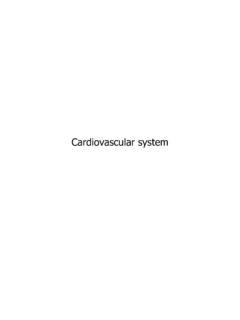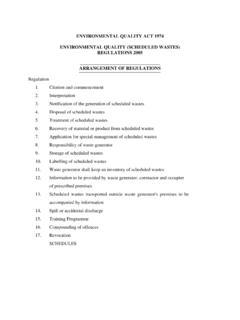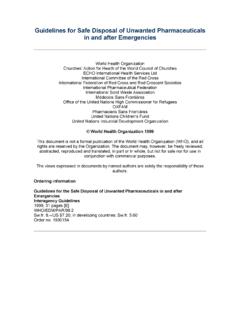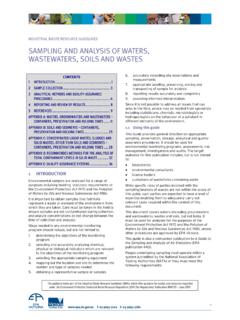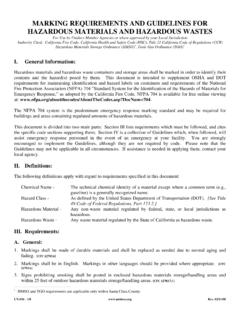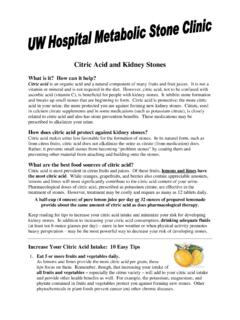Transcription of EXCRETION Introduction Major Metabolic Wastes
1 EXCRETION Introduction Humans must get rid of two types of Wastes . Wastes from the digestive system (feces) and Wastes from Metabolic activities (sweat & urine). Removing digestive Wastes (pooping) is called egestion. Removing Metabolic Wastes is called EXCRETION . Major Metabolic Wastes Table (1) summarizes the four types of Metabolic Wastes produced by humans (and other animals), and the type of chemical reactions that produce them. Metabolic waste TYPE OF CHEMICAL REACTIONS Water Dehydration synthesis & respiration Carbon dioxide Cellular respiration Salts Neutralization Urea Protein metabolism, deamination Table 1. The Major Metabolic waste products of human. Dehydration synthesis = reactions in which small molecules are combined to form large molecules Cellular respiration = chemical reaction that releases energy from organic molecules (usually glucose and fatty acids) Neutralization = reactions between acids & bases Deamination = removal of amino groups from protein molecules Remarks on the nitrogenous Wastes Amino acids Digestion of proteins leads to hydrolyze them to their respective amino acids.
2 Excess of amino acids are excreted as such without any change by certain animals such as molluscs, echinoderma etc. Human excrete minor amounts of some amino acids in the urine. Ammonia Ammonia is formed as a result of deamination of amino acids. Ammonia is a poisonous, so it presents only in low concentration in the blood of many animals. In humans, levels of only 5 mg per 100 ml of blood are toxic, and the normal concentration of this metabolite is only 1 to 3 micrograms per 100 ml of human blood. Fishes do not have concentrations of ammonia greater than mg (100 micrograms) per 100 ml of blood. Because ammonia is toxic, it apparently combined with glutamic acid to give glutamine. Glutamine is carried through the blood circulation to a membrane next to the surrounding water (the gills for fishes and certain other animals) where it converted again to glutamic and ammonia, which is excreted into the water (Fig.)
3 1). Humans excrete ammonia in 2 the urine in the form of ammonium ions (NH4+), and presumably the ammonia is formed also from glutamine in the kidneys. The amount of ammonium ions excreted is not very large, and there is no detectable EXCRETION of ammonia by normal humans. The reversible reaction between ammonia and glutamic acid can be described as follows: Urea It is the Major nitrogenous waste product derived from amino acid metabolism. It is also excreted by some animal as an end product of purine bases metabolism. Urea is less toxic and more soluble in water than ammonia. Levels between 18 and 38 mg/100 ml of blood are considered normal in humans. In sea sharks, concentrations of urea as much as 2 g/100 ml of blood are found, while in freshwater sharks concentration of urea was much less, it is about g/100 ml of blood. This gives evidence that urea is involved in regulation of the osmotic pressure in salty sea water sharks.
4 In livers of mammals, urea is synthesized from ammonia through a series of reactions known as urea cycle (Fig. 2). Ammonia is firstly converted to the carbamyl phosphate, and an enzyme called arginase is required to release of urea from arginine in the presence of. Energy is required for synthesis of urea. 3 Uric acid It excreted by the animals which conserve water, at least during parts of their life cycle, such as birds, terrestrial reptiles, insects, and some snails. In this case ammonia is converted into uric acid. It is less toxic than ammonia but it is insoluble in water. Uric acid is excreted in crystalline form mixed with, but not dissolved in, small amounts of water. In fowls (chickens and turkeys), blood level of uric acid is about 5 mg/100 ml, while insects have as much as 20 mg uric acid/100 ml of blood. The synthesis of uric acid is a complex, energy-requiring process. Humans excrete uric acid as an end product of the metabolism of purine bases adenine and guanine.
5 Uric acid is formed also by a direct synthesis from 5-phosphoribosyl pyrophosphate and glutamine. Levels of uric acid in human blood is about mg/100 ml in men and mg/100 ml in women. Trimethylamine oxide This nitrogenous excretory product is formed in marine teleost fishes. Guanine This nitrogenous excretory product is formed in the spiders and swine. Its solubility is very low. Allantoin It is formed from uric acid via an oxidation reaction catalyzed by an enzyme uricase. It excreted in some mammals, reptiles, and molluscs. Hippuric acid This acid is found in mammals. The benzoic acid present in the food of mammals is removed and it combines with glycine to form hippuric acid. Ornithuric acid In birds, this excretory product is formed by combination of the nitrogenous compound ornithine with benzoic acid which is present in the food of these animals. Creatine Creatine is synthesized in the liver from three amino acids namely, arginine, glycine, and methionine.
6 Creatine is liberated into the blood and is taken up by the muscle when required. In skeletal muscle, it is phosphorylated to form creatine phosphate, which is an important energy store for ATP synthesis. The excess of creatine is excreted along with urine. Creatinine It is formed in the body from creatine phosphate. Creatine is not converted directly to creatinine. The rate of creatinine EXCRETION is constant from day to day. Classification of animals on basis of types of nitrogenous compounds excreted Ammonotelic The animals of this group excrete nitrogen mainly in the form of ammonia. This is predominantly among aquatic animals, certain unicellular animals, teleosts, tadpoles, polycheate annelids, Aplysia, molluscs, crocodiles, and crustaceans. Ureotelic 4 In these animals, nitrogen excreted predominantly in the form of urea, mammals, amphibians, and elasmobranchs. Among fishes, both ammonotelic and ureotelic metabolism are present.
7 Uricotelic Animals are described as being uricotelic when nitrogen is excreted predominantly in the form of uric acid, birds, insects, lizards, snakes, and some gastropods. HUMAN EXCRETORY ORGANS There are 4 excretory organs in human: The skin, the lungs, the liver, and the kidney (Urinary system). THE SKIN The skin excretes the sweat outside the body through numerous pores in the surface of this organ. Sweat is a mixture of three Metabolic Wastes : water, salts, and urea. So as you sweat, your body accomplishes two things: 1) sweating has a cooling effect on the body, and 2) Metabolic Wastes are excreted. The skin is formed of two layers; the thin epidermis at the top, and the thicker dermis below. The inner layer of skin (dermis) contains the oil glands, hair follicles, fatty layers, nerves, and sweat glands. The sweat gland leads to the sweat duct (tube) which opens on the skin surface through a pore (Fig.
8 3). 5 Sweat formation Notice that the sweat gland is a tubular structure tangled with the blood capillaries. This close association of tubes allows Wastes (namely water, salts, and urea) to diffuse from the blood into the sweat gland. When body temperature rises, the fluid (sweat) is released from the gland, travels through the duct, and reaches the skin surface through openings called pores. THE LUNGS Cellular respiration occurs in every living cell in your body. It is the reaction that provides energy (in the form of ATP molecules) for cellular activities. If respiration stops, the cell no longer has energy for cellular activities, and the cell dies. As respiration occurs carbon dioxide is produced as a waste product. As the carbon dioxide accumulates in body cells, it eventually diffuses out of the cells and into the bloodstream, which eventually circulates to the lungs.
9 In the alveoli of the lungs, carbon dioxide diffuses from the blood, into the lung tissue, and then leaves the body every time we exhale. Some water vapor also exits the body during exhalation. THE LIVER The liver is a large, important organ in our bodies. Its numerous functions make it "part" of the circulatory, digestive, and excretory systems. Liver as an excretory organ acts to breakdown some proteins and other nitrogenous compounds by a process called deamination. As a result of these reactions, a nitrogenous waste called urea is formed. Liver as well as helps in excreting toxic substances, drugs, and their derivatives; and bile pigments and cholesterol. THE URINARY SYSTEM IN HUMAN (THE KIDNEY) Generally, EXCRETION means the separation and elimination of waste materials from the body through a special structure called the excretory organ. Specifically, the act of EXCRETION is a two-fold function: it eliminates substances that have reached their threshold concentration in the blood, and it retains or reabsorbs substances that are below this concentration.
10 Both functions, however, are homeostatic, tending to maintain a stable environment within the body. The Major functions of the excretory systems can be summarizes as follows: 1. Maintenance of proper concentrations of individual ions (Na+, K+, Cl-, H+, etc.). 2. Maintenance of proper body volume by regulating water content. 3. Maintenance of osmotic concentrations, which result from the ability of the excretory systems to control water and electrolytes contents in the body. 4. Removal of Metabolic end products ( , urea, uric acid, etc.). 5- Removal of foreign substances and/or their Metabolic products. 6 EXTERNAL STRUCTURE Two Kidneys They are dark, red, bean-shaped and lie in the upper part of the abdominal cavity against the dorsal body wall (Fig. 4). They are embedded in a protective layer of fat and connective tissue. The right kidney is slightly on a lower level than the left. Each Kidney is about 4 inches long, 2 inches broad, and over one inch thick.

